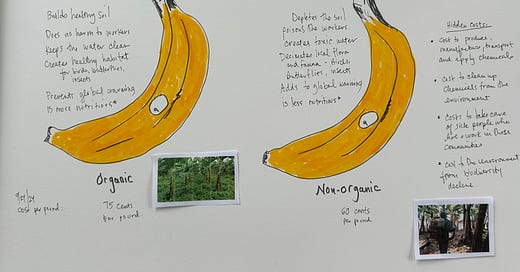I recently met a truly beautiful woman. She was the kind of woman who could be intimidating, except she was really sweet and nice. We got to talking and she asked what I did and that got us onto the topic of organic.
“I try to buy organic most of the time,” she said. “But sometimes things like regular bananas are cheaper and because they are still in the peel I buy those instead.”
I can understand the price sensitivity for buying food. But this woman was well off enough that I knew she could afford it if she chose to. Rather than judge (not my job), my mind started running numbers, calculating a lifetime of facts and knowledge, and printed out a picture in my head of a side-by-side comparison. Of course, at the party with loud music and the time getting late, I couldn’t explain to her what I saw in my head. This morning I drew it.
I’m actually thinking about going back to art school so that I can take these pictures in my head and turn them into serious infographics (fun fact, I have a degree in art from a long, long time ago before computers). So pardon the hand-drawn sketchiness of it. But the basic idea is to do a quick side-by-side showing the real price of our choices. So many good people put on their price-sensitive goggles in the supermarket but then, from the genuine goodness of their hearts, donate even more dollars to health and environmental causes. What if…WHAT IF…we could PREVENT so many of the environmental and health problems just by spending a few extra dollars at the supermarket?
As of today, the average price difference per pound of organic vs. non-organic bananas is only 15 cents more per pound. What I didn’t put in my little drawing was that one of the reasons non-organic bananas cost less in the supermarket is the money spent in Washington on price subsidies for all the players along the chain of the conventional banana industry. (As an aside, I am not getting into the political history of banana farming — too complicated.)
In case you don’t want to read the fine print, here’s what it says on the organic side:
Builds healthy soil
Does no harm to the workers
Keeps the water clean
Creates healthy habitats for birds, butterflies, and insects
Prevents global warming
Is likely to be more nutritious
On the non-organic side, it says this:
Depletes the soil
Poisons the workers
Creates toxic water
Decimates local flora and fauna (birds, butterflies, and insects)
Adds to global warming
Is likely less nutritious
The other list is the hidden costs of chemical banana production:
The cost to produce, manufacture, and transport the chemicals
The cost to clean up chemicals from the environment
The cost to take care of sick people who live and work in those communities
The cost to the environment from biodiversity decline
Now, I am not an agro-economist, although sometimes I wish I were. So, I am not able to calculate the actual costs and impacts of these choices. But based on my Maria math, it’s A LOT.
And while I am not certain if there is nutritional comparison research on bananas, based on early results of vegetable comparisons at the Rodale Institute, it is safe to say there are likely similar results in bananas and other fruits.
I don’t remember the name of the lovely woman at the party. But I will always be grateful to her that our conversation enabled me to put this comparison on paper and share it with all of you. Let me know what you think!
And thanks for being here. I appreciate it.





Yes, you should continue the graphics. All I had to do was look at your banana picture and understood quickly what to do.
I attended high school and worked as a docent at the Los Angeles Zoo where chimpanzees were often given both organic and conventional bananas. With the organic bananas, they would eat them whole, skin and all, but they’d always peel the conventional ones. Organic bananas are still just $0.69/lb in my local store, even cheaper than conventional apples, peaches, pears, citrus etc. Hard to imagine that pricing results in a living wage for growers in that value chain, but that’s another issue.